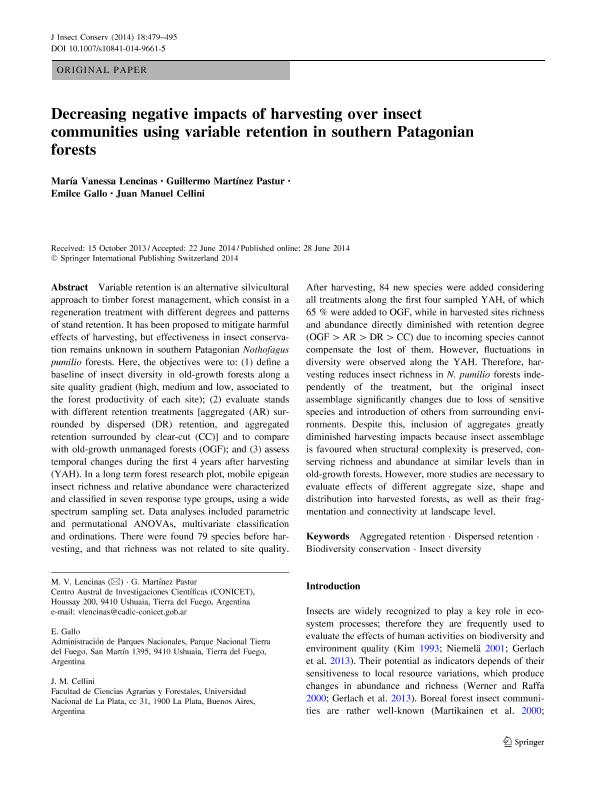Artículo
Decreasing negative impacts of harvesting over insect communities using variable retention in southern Patagonian forests
Fecha de publicación:
06/2014
Editorial:
Springer
Revista:
Journal of Insect Conservation
ISSN:
1366-638X
Idioma:
Inglés
Tipo de recurso:
Artículo publicado
Clasificación temática:
Resumen
Variable retention is an alternative silvicultural approach to timber forest management, which consist in a regeneration treatment with different degrees and patterns of stand retention. It has been proposed to mitigate harmful effects of harvesting, but effectiveness in insect conservation remains unknown in southern Patagonian Nothofagus pumilio forests. Here, the objectives were to: (1) define a baseline of insect diversity in old-growth forests along a site quality gradient (high, medium and low, associated to the forest productivity of each site); (2) evaluate stands with different retention treatments [aggregated (AR) surrounded by dispersed (DR) retention, and aggregated retention surrounded by clear-cut (CC)] and to compare with old-growth unmanaged forests (OGF); and (3) assess temporal changes during the first 4 years after harvesting (YAH). In a long term forest research plot, mobile epigean insect richness and relative abundance were characterized and classified in seven response type groups, using a wide spectrum sampling set. Data analyses included parametric and permutational ANOVAs, multivariate classification and ordinations. There were found 79 species before harvesting, and that richness was not related to site quality. After harvesting, 84 new species were added considering all treatments along the first four sampled YAH, of which 65 % were added to OGF, while in harvested sites richness and abundance directly diminished with retention degree (OGF > AR > DR > CC) due to incoming species cannot compensate the lost of them. However, fluctuations in diversity were observed along the YAH. Therefore, harvesting reduces insect richness in N. pumilio forests independently of the treatment, but the original insect assemblage significantly changes due to loss of sensitive species and introduction of others from surrounding environments. Despite this, inclusion of aggregates greatly diminished harvesting impacts because insect assemblage is favoured when structural complexity is preserved, conserving richness and abundance at similar levels than in old-growth forests. However, more studies are necessary to evaluate effects of different aggregate size, shape and distribution into harvested forests, as well as their fragmentation and connectivity at landscape level.
Archivos asociados
Licencia
Identificadores
Colecciones
Articulos(CADIC)
Articulos de CENTRO AUSTRAL DE INVESTIGACIONES CIENTIFICAS
Articulos de CENTRO AUSTRAL DE INVESTIGACIONES CIENTIFICAS
Citación
Lencinas, María Vanessa; Martínez Pastur, Guillermo José; Gallo, Emilce; Cellini, Juan Manuel; Decreasing negative impacts of harvesting over insect communities using variable retention in southern Patagonian forests; Springer; Journal of Insect Conservation; 18; 3; 6-2014; 479-495
Compartir
Altmétricas




